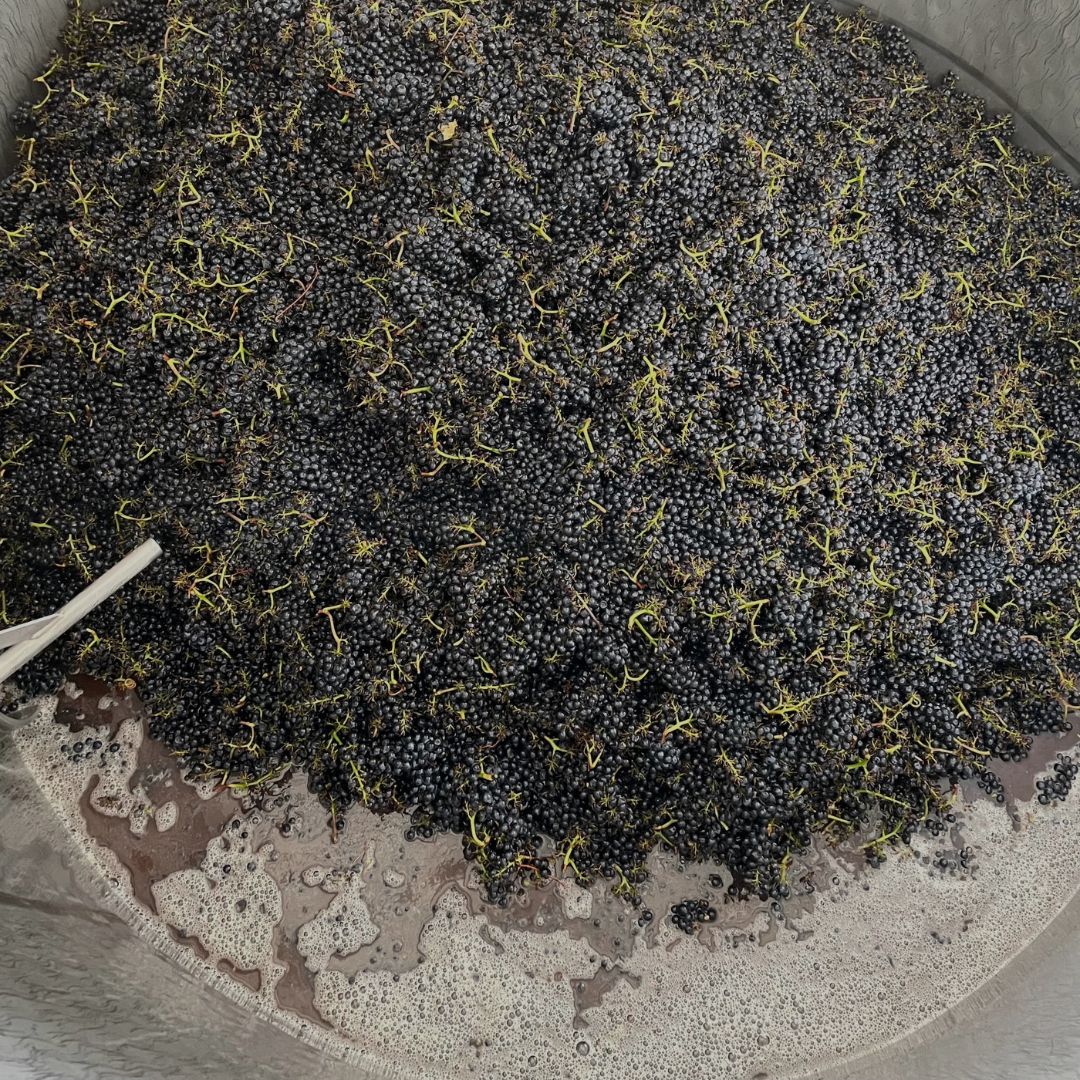
17 Mar Exploring Whole-Cluster Fermentation in Red Wine
I’ve played around with whole-cluster fermentation in Pinot Noir for years, but in 2022, I fully committed to it. After seeing how it enhanced structure and complexity in small experimental batches, I realized its potential as a key tool for expressing terroir. That year’s vintage, with its ideal balance of ripeness and stem lignification, was the perfect opportunity to go all in. This old-school technique—fermenting grapes with their stems still attached—is making a big comeback among winemakers looking to add serious depth and complexity to their wines.
What is Whole-Cluster Fermentation?
Instead of removing the stems before fermentation, we keep the entire grape bunch intact. This simple decision has a huge impact on the final wine, influencing everything from texture to aroma to the way the tannins feel on your palate.
At Joseph Jewell, we layer the whole clusters at the bottom of the tank and then layer the percentage of destemmed fruit on top. If the percentage of whole cluster is 20%, then 80% of the fruit has been destemmed. This careful layering approach helps us achieve the precise balance and integration we’re looking for in the final wine.
Why It’s a Game-Changer for Pinot Noir
Pinot Noir is already known for its elegance and complexity, but whole-cluster fermentation takes it to another level. By leaving the stems intact, we unlock layers of texture, aroma, and structure that wouldn’t be possible with destemmed fruit alone. Here’s why this method is a game-changer:
- Bigger, Bolder Aromas – Stems add lifted floral and spicy notes, making the wine’s scent more layered and expressive.
- Smoother, More Complex Tannins – The tannins from stems help give the wine structure without making it harsh.
- Livelier, More Vibrant Acidity – Whole-cluster fermentation helps Pinot Noir stay fresh and energetic.
- More Depth & Complexity – This process brings out unexpected flavors, from bright red fruit to earthy, herbal notes.
- Helps Fermentation Naturally – Stems create better drainage and airflow, keeping fermentation on track.
Fully embracing this method has changed the way I make wine, allowing Pinot Noir to tell a richer, more authentic story of the vineyard. I’m excited to keep exploring where this takes my wines and share the journey with you.
The Do’s and Don’ts of Whole-Cluster Fermentation
Not all wines benefit from whole-cluster fermentation. Choosing the right fruit is key to ensuring balance and avoiding undesirable characteristics. Here are some essential guidelines:
Do’s:
- Use small to medium, tightly packed clusters – These tend to produce better structure and complexity in the final wine.
- Select vineyards with lignified (brown, not green) stems – This prevents harsh, bitter flavors from developing.
- Opt for well-balanced fruit – Whole-cluster fermentation enhances aromas and tannins, so starting with quality fruit is essential.
- Experiment with different percentages – Some wines benefit from 100% whole-cluster, while others shine with just a portion of the fruit fermented this way.
Don’ts:
- Avoid vineyards with large, loose clusters or excessive shatter – Gaps between berries can lead to uneven fermentation and less desirable textures.
- Stay away from fruit with overly green stems – This can introduce harsh, herbaceous flavors that overpower the wine.
- Don’t assume all grape varieties respond the same way – Some varietals, like Pinot Noir and Syrah, thrive with whole-cluster, while others may not benefit as much.
Understanding these factors has helped refine my winemaking approach, allowing me to harness the benefits of whole-cluster fermentation while avoiding potential pitfalls.
Featured Whole-Cluster Fermentation Wines
2022 Grenache Russian River Valley: 50% whole-cluster
This Grenache is light-bodied yet structured, with fine, medium-minus tannins providing a gentle grip. Juicy strawberries and cherry Jolly Rancher flavors lead, balanced by earthy undertones and resinous herbs. The finish is long and savory, with an alluring umami character that lingers on the palate. A beautifully nuanced expression of Grenache from the Russian River Valley.
2023 Eel River Valley Pinot Noir: 18% whole-cluster
The 2023 Eel River Valley Pinot Noir displays a beautiful ruby red hue, with a delightful bouquet of bing cherry intertwined with savory notes of thyme. The aroma is further enhanced by hints of black tea and a touch of exotic Asian spice. The palate is medium-bodied, offering a well-balanced profile with soft acidity, pleasing minerality, and spice notes from the aroma carrying through to a satisfying finish.
2022 Hallberg Vineyard Pinot Noir: 17% whole-cluster
A lively interplay of tart cherries, red currants, and cranberries leads on the palate, complemented by a savory undertone and a touch of salinity that adds depth. The herbal character intensifies on the finish, where hints of cedar and redwood needles lend an earthy complexity. With bright acidity and fine balance, this Pinot Noir is a pure, site-driven expression of Hallberg Vineyard.



